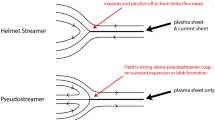Abstract
The problem of pulsar radio emission for the case of a coaxial rotator was investigated in our preceding paper [G. S. Sahakian, Astrofizika,38, 143 (1995)]. In this paper it is solved for the realistic case in which the star's magnetic axis does not coincide with its rotational axis (an inclined rotator). It is shown that above the star's magnetic cap a special region, called a magnetic funnel, is formed in which vigorous processes of particle multiplication occur. The height of this region is h ≈ 8·106Ω0.2μ 1/330 R 1.36 cm and its radius r(Ωr/c)0.5 depends little on the inclination angle a (Ω is the angular rotation rate, μ is the magnetic moment, R is the star's radius, and r is distance from the center of the star). It is shown that the pulsar radio emission is produced in the magnetic funnel. Here, in the course of active radiative processes, two main particle fluxes with a high ultrarelativistic energy are formed: an upward electron flux and a positron flux falling onto the star's magnetic cap. These main fluxes are accompanied by individual narrow strips of positron and electron fluxes with a relatively low energy, which are fairly powerful, coherent radio sources. Such secondary fluxes are formed immediately after the annihilation of photons of curvature radiation emitted by particles of the main fluxes. The pulsar's radio luminosity is estimated to be L≈7.4·1023Ω3.52μ 8/330 ψ(a), where ψ(a) is a known function (ψ≈1 for a<50°). Equating the theoretical and observed radio luminosities L and L0, we obtain the formula μ30≈P1.32R 0.46 (2.1·10−27L0/ψ)3/8 for the magnetic moment of the pulsar's neutron star, where P is the pulsar's period. The magnetic moments of slow pulsars calculated from this formula turn out to be considerably larger than those of fast pulsars. This means that the masses of slow pulsars are larger, on the average, than those of fast pulsars. The magnetic funnel operates with interruptions, periodically undergoing a discharge, so that the production of pulsar radio emission operates with interruptions. The durations of the production of radio emission and of the interruptions between those processes are on the order of h/c≈2.7·10−4Ω0.2μ 1/330 sec, i.e., pulsar radio emission has a microstructure. Consequently, a study of the microstructure of the profiles of observed radio pulses enables one to obtain additional information about the magnetic moments of the neutron stars.
Similar content being viewed by others
Literature cited
T. Gold,Nature (London),221, 25 (1969).
P. Goldreich and W. H. Julian,Astrophys. J.,157, 869 (1969).
P. A. Sturrock,Astrophys. J.,164, 529 (1971).
F. C. Michel,Astrophys. J.,180, 207 (1973).
L. Mestel,Astrophys. Space Sci.,24, 289 (1973).
M. A. Ruderman and P. G. Sutherland,Astrophys. J.,196, 51 (1975).
L. Mestel and Y. M. Wang,Mon. Not. R. Astron. Soc.,188, 799 (1979).
F. C. Michel,Rev. Mod. Phys.,54, 1 (1982).
V. S. Beskin, A. V. Gurevich, and Ya. N. Istomin,Zh. Éksp. Teor. Fiz.,58, 401 (1983).
V. S. Beskin, A. V. Gurevich, and Ya. N. Istomin,Usp. Fiz. Nauk,150, 257 (1986).
G. S. Sahakian,Astrofizika,37, 97 (1994).
G. S. Sahakian and É. V. Chubarian,Astrofizika,37, 255 (1994).
G. S. Sahakian,Astrofizika,38, 143 (1995).
G. S. Sahakian,Equilibrium Configurations of Degenerate Gaseous Masses [in Russian], Nauka, Moscow (1972) [G. S. Saakyan,Equilibrium Configurations of Degenerate Gaseous Masses, Wiley, New York (1974)].
L. Sh. Grigorian and G. S. Sahakian,Astrophys. Space Sci.,95, 305 (1983).
J. M. Rankin,Astrophys. J.,405, 285 (1993).
G. S. Sahakian,Astrofizika,36, 87 (1993).
T. Erber,Rev. Mod. Phys.,38, 516 (1966).
Author information
Authors and Affiliations
Additional information
Translated from Astrofizika, Vol. 39, No. 2, pp. 313–335, April–June, 1996.
Rights and permissions
About this article
Cite this article
Sahakian, G.S. Pulsar radio emission. I. Oblique rotator. Astrophysics 39, 169–182 (1996). https://doi.org/10.1007/BF02044801
Received:
Issue Date:
DOI: https://doi.org/10.1007/BF02044801




